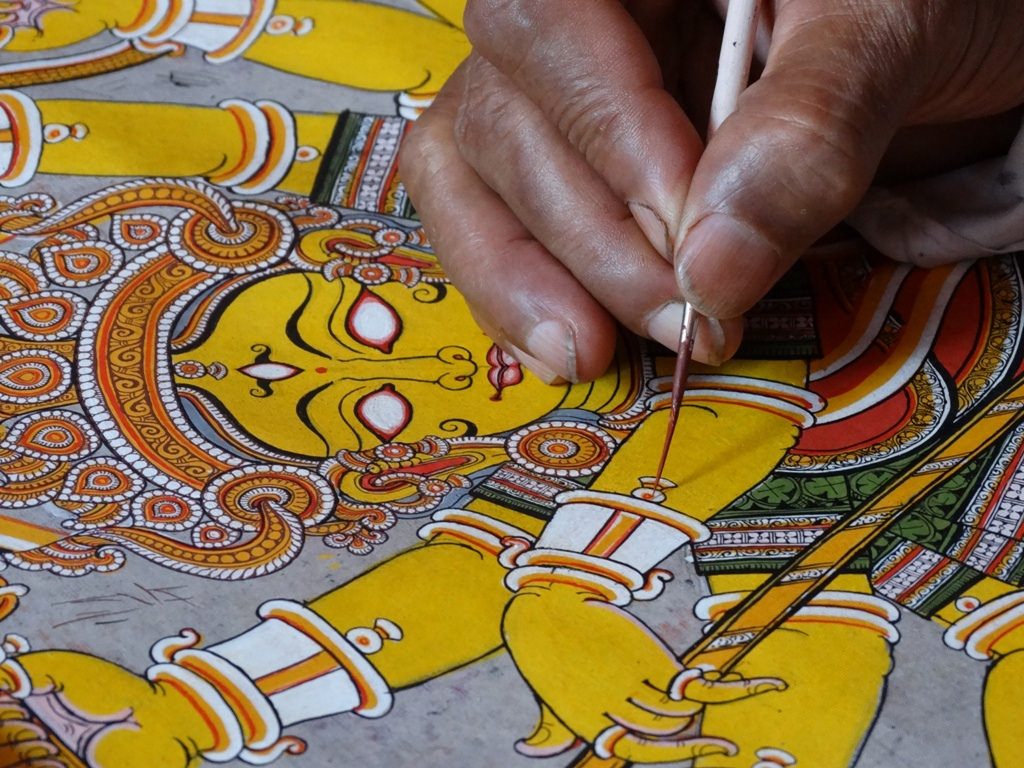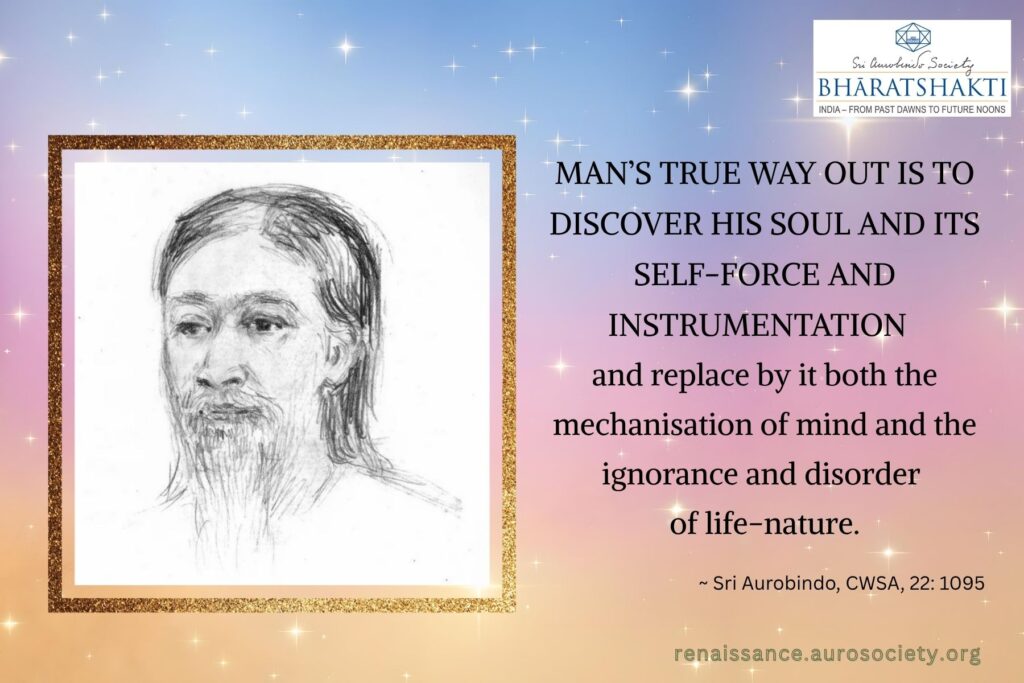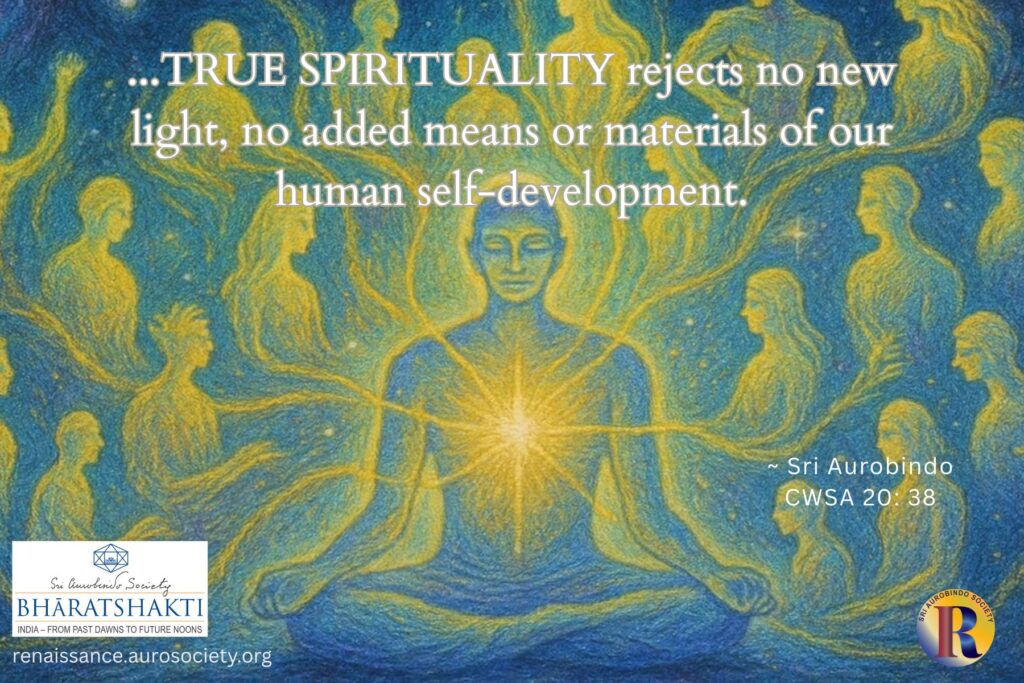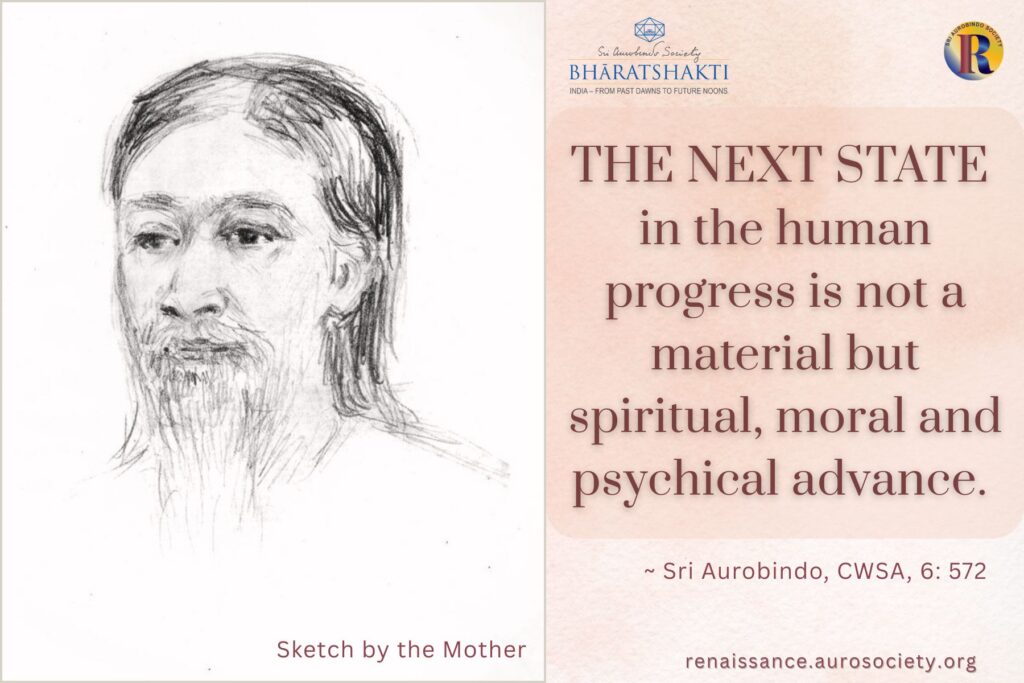Volume 1, Issue 8
Author: Beloo Mehra
India celebrates Navaratri this month – the festival of nine nights to invoke the force of the Divine Mother, the Divine Feminine, through her different manifestations. Shakti – the Divine Mother is naturally the appropriate theme of the present issue of Renaissance.
Sri Aurobindo once spoke of shakti simply as “the female principle in Nature which is at the root of all action” (CWSA, Vol. 13, pp. 27-28). In India, we see all our goddesses as forms of shakti, each one a unique manifestation of the universal shakti, the universal conscious-force, the chit-shakti. These shakti-s are energies of the one Energy of the highest divine Being.
The invocation and worship of the Divine Mother is an integral part of Indian religio-spiritual traditions. The ancient Indian mind saw that “Shiva and Kali, Brahman and Shakti are one and not two who are separable” (CWSA, Vol. 21, p. 90). Durga, one of the forms of the Mother worshipped during Navaratri, represented as having ten different weapons in Her hands and sitting on a lion, is the “Mother’s power of Protection,” said Sri Aurobindo (CWSA, Vol. 32, p. 69). But with Durga, comes Kali too.
It is only a few religions which have had the courage to say without any reserve, like the Indian, that this enigmatic World-Power is one Deity, one Trinity, to lift up the image of the Force that acts in the world in the figure not only of the beneficent Durga, but of the terrible Kali in her blood-stained dance of destruction and to say, “This too is the Mother; this also know to be God; this too, if thou hast the strength, adore.”
And it is significant that the religion which has had this unflinching honesty and tremendous courage, has succeeded in creating a profound and wide-spread spirituality such as no other can parallel. For truth is the foundation of real spirituality and courage is its soul.
(Sri Aurobindo, CWSA, Vol. 19, p. 45)
In the Devi Sukta of the Rigveda Samhitā (10.125) we find that Vāk, symbolising speech, the daughter of the sage Vāgāmbhṛṇī, realised her identity with the Divine Mother, the Power of the Supreme Lord. This power manifests throughout the universe among the gods, among humans and beasts, and among the creatures of the deep ocean. In the Kena Upanishad, we meet the Divine Mother in the form of Uma, granting wisdom to Indra and other gods, who are shown the truth that they were able to defeat the asuras or demons only with the help of the Power, the Shakti of the Supreme Lord.
Many are the means and ways of Her working, because manifold indeed are her aspects and forms. She works through her various powers and she transcends them all. She works on the plane of this world of ignorance, and she guides the entire earth-play through her Supreme Force. She is the Individual, the Universal and the Transcendent; She expresses herself in Form and in No-Form.
We adore the Supreme Shakti, the Devi which is the conscious power, executive energy of the Lord. But we must not forget that the words Devi and Shakti are by no means Her ultimate definitions. The primordial or Adi Shakti is beyond intellectual comprehension. Truly speaking, all beings in the universe are Shakti worshippers, whether they are aware of it or not, for there is no one who does not aspire for power and energy in some form or other. Science has now proved that everything is pure, imperishable energy. This energy is only a form of divine Shakti which exists in every form.

Sri Aurobindo reminds us that each nation is also essentially a shakti, the power of evolving spirit in humanity. One of the most significant works of Sri Aurobindo, – among many other equally significant works – has to do with the Mother element, which he invoked in three specific and highly momentous ways.
First, was the awakening of the Mother element, the Shakti element in the sleeping India, when he reminded Indians of the force of the mantra of Bande Mataram which had been lying dormant in some ideative field of the nation. Sri Aurobindo charged it with a spiritual sense and the whole country woke up in response. The awakening of Shakti took the form of an aspiration for freedom.
Second was when Sri Aurobindo placed the Shakti, the Divine Mother in the forefront at the Ashram. By doing this, he gave a new orientation to his Yoga. Instead of relying on the Purusha, yoga was now going to be based on a dynamic Shakti. This is what makes Integral Yoga truly Integral, because it is now fully integrated with Life. We see this element of integration in all developments of yoga that came afterwards.
Third was when Sri Aurobindo embodied the consciousness of the Mother in the sound-word of Savitri.
At the head she stands of birth and toil and fate,
In their slow round the cycles turn to her call;
Alone her hands can change Time’s dragon base.
Hers is the mystery the Night conceals;
The spirit’s alchemist energy is hers;
She is the golden bridge, the wonderful fire.
The luminous heart of the Unknown is she,
A power of silence in the depths of God;
She is the Force, the inevitable Word,
The magnet of our difficult ascent,
The Sun from which we kindle all our suns,
The Light that leans from the unrealised Vasts,
The joy that beckons from the impossible,
The Might of all that never yet came down.
All Nature dumbly calls to her alone
To heal with her feet the aching throb of life
And break the seals on the dim soul of man
And kindle her fire in the closed heart of things.
All here shall be one day her sweetness’ home,
All contraries prepare her harmony;
Towards her our knowledge climbs, our passion gropes;
In her miraculous rapture we shall dwell,
Her clasp shall turn to ecstasy our pain.
Our self shall be one self with all through her.
(Savitri, Book III, Canto II, CWSA, Vol. 33, p. 314)
Shakti, the primordial cosmic energy which represents the dynamic forces that are thought to move through the entire universe, is the divine feminine creative power. This is why in Indian culture, the woman is traditionally seen as the shakti, the force and energy.
This is not to say that shakti is something to be found only in women. It is the creative power, the energy present in all of us, but the nature of this energy is feminine because it is only the female who has the potential to create new beings within herself. All creation – material, intellectual, aesthetic, spiritual – all is possible only because of the shakti, the cosmic energy.
I have within me a thing called shakti – force. My action, my inspiration, my emotion, my desire, my idea, my thought – all are being controlled by that force. The movement of my soul is the pull of that force. This force of mine within is woman named without.
(Nolini Kanta Gupta, ‘About Woman’, 1999, p. 10)

The present issue of Renaissance is dedicated to invoking several of the names and forms of Shakti. From Aditi, the Divine Mother to Mother India, the Bhārata Shakti; from Mahāshakti and Her Four Great Powers to Woman as shakti, nāri shakti. The different sections of the issue have Shakti as the underlying theme, because Hers indeed is the force that moves all and acts in all, the universal Energy, the Conscious-Power.
There is no better way to close this editorial than a small prayer.
This Navaratri let us approach the Mother with an open heart, lay bare our heart to Her with frankness and humility, love her with a simple heart like that of a child, without any pretence or arrogance. In her boundless Grace, in her illimitable Love, in her infinite Knowledge, and in her immeasurable Power, she blesses us all.
This Navaratri, let us also remember that it is when the darkness of the ignorance and falsehood begins to engulf our minds and hearts, that we must pray more fervently for the light of wisdom and truth. And the Mother will answer. She always does.
You know the story of Durga, don’t you? Durga who every year has to destroy her asura; and always she is compelled to begin again. It goes on in this way till the end of the reign allotted to the titans. When they will be banished from this world, it will not be thus any longer.
But till then, that is as long as they are useful…for intensifying the aspiration, clarifying the consciousness, for putting to the test the sincerity of people, they will be there. The day the test will not be needed, the day the sincerity will be pure and self-existent they will disappear. Then that day, Durga will no longer need to begin her battle over again every year.
(The Mother, CWM, Vol. 5, pp. 96-97)
As always, we offer this work at the feet of Sri Aurobindo and the Mother.
In gratitude,
Beloo Mehra (for Renaissance Editorial Team)
Cover photo – Navadurga, Madhubani painting, source



